Birdfinding.info ⇒ Among the three Pterodroma petrels that breed in Macaronesia, Cape Verde is the most numerous but the most difficult to find and identify away from its breeding islands. It can be found consistently during most of the year (at least September to June) in the waters of Cape Verde, especially around Santo Antão and west of São Nicolau. Probable records from North Carolina waters remain inconclusive due to its similarity to the Desertas Petrel.
Cape Verde Petrel
Pterodroma feae
Breeds in Cape Verde and disperses to warm waters of the eastern Atlantic.

Cape Verde Petrel confirmed location data. Ramos et al. 2016
Breeds from September to June at upper elevations of four islands of the Cape Verde archipelago: Santo Antão (>200 pairs), São Nicolau (~30 pairs), Fogo (~50 pairs), and Santiago (~50 pairs).
Movements. Geolocator-based tracking studies of several birds from the Fogo colony have found that this population (and perhaps the species as a whole) is essentially non-migratory, and that it remains in tropical and subtropical waters of the eastern Atlantic between 40° North and 5° South, dispersing about equally north and south of Cape Verde, roughly between the Azores and Ascension Island.
Possible occurrence in the western North Atlantic remains unconfirmed. Among the small numbers of “Fea’s Petrels” seen each year offshore from Cape Hatteras, North Carolina, in May and June, a minority of those observed or photographed clearly enough to evaluate have been molting their flight feathers. To be at that stage of molt at that time of year is more consistent with Cape Verde than with Desertas Petrel—because it is the end of Cape Verde’s breeding season but the beginning of Desertas’s—so the strong implication is that these individuals must have been Cape Verde Petrels. This inference seems sound, but thus far it lacks corroboration from geolocator tracking of Cape Verde Petrels (a limited sample taken entirely from one of four subpopulations).
Identification
A mid-sized gadfly petrel with gray upperparts, white underparts, and dark wings.
Effectively identical to Desertas Petrel—the two are often combined under the name Fea’s Petrel, either taxonomically as a single species or just for practical purposes in field identification (see below).
Their most noticeable features are a gray partial hood, or cowl, blackish eye-patches, a white throat, a pale-gray rump and tail, a dark “M” across the back and wing, and mostly dark-gray underwings with contrasting whitish patagial wedges.
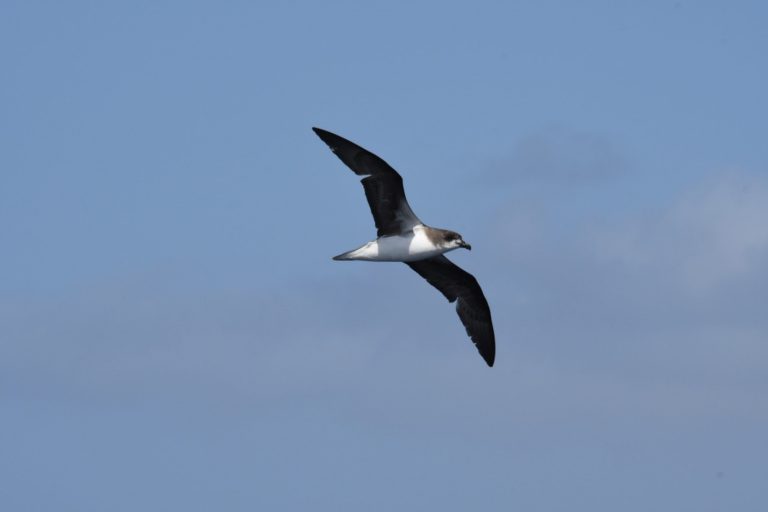
Cape Verde Petrel, showing underwing as it usually appears: all-dark except for a pale patagial wedge. © Jacob González-Solís
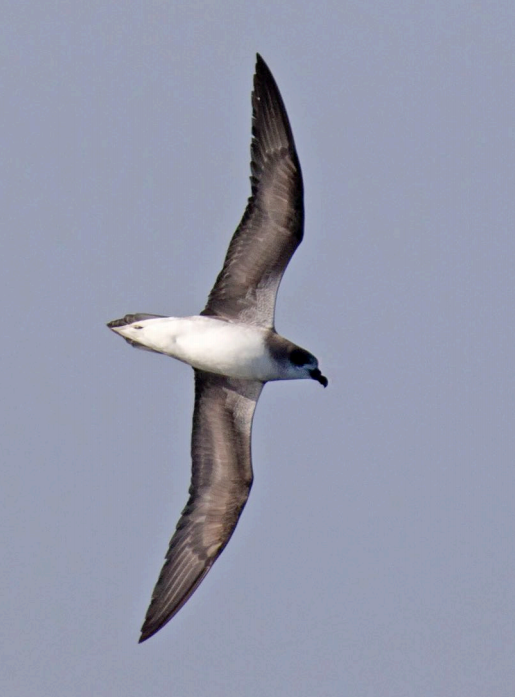
Cape Verde Petrel, showing mostly medium-gray underwing with blackish carpal bar, tip, and trailing edge. (Offshore from São Nicolau, Cape Verde; March 2017.) © BirdQuest

Cape Verde Petrel, showing gray upperparts with dark “M” and pale-gray rump and tail. (Offshore from Fogo, Cape Verde; April 18, 2016.) © Peter Kaestner

Cape Verde Petrel, showing gray cowl and mostly dark underwings. (South of Mayo, Cape Verde; March 24, 2018.) © Peter Bono
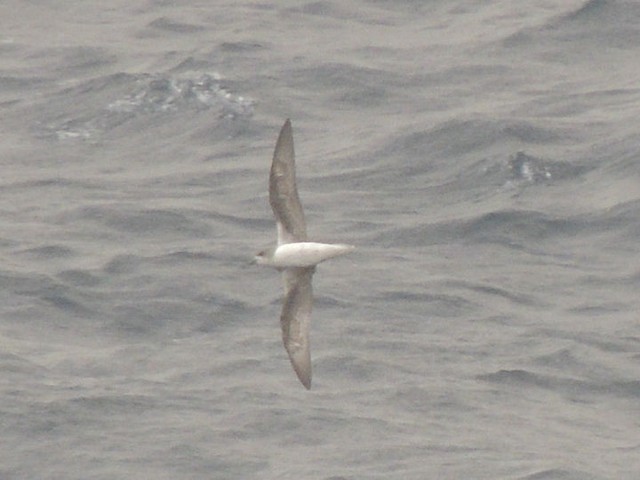
Cape Verde Petrel, showing mostly medium-gray underwing with blackish carpal bar, tip, and trailing edge. (South of Mayo, Cape Verde; March 24, 2018.) © Peter Bono

Cape Verde Petrel, showing gray cowl and mostly dark underwings. (Offshore from Fogo, Cape Verde; April 10, 2018.) © Noah Strycker
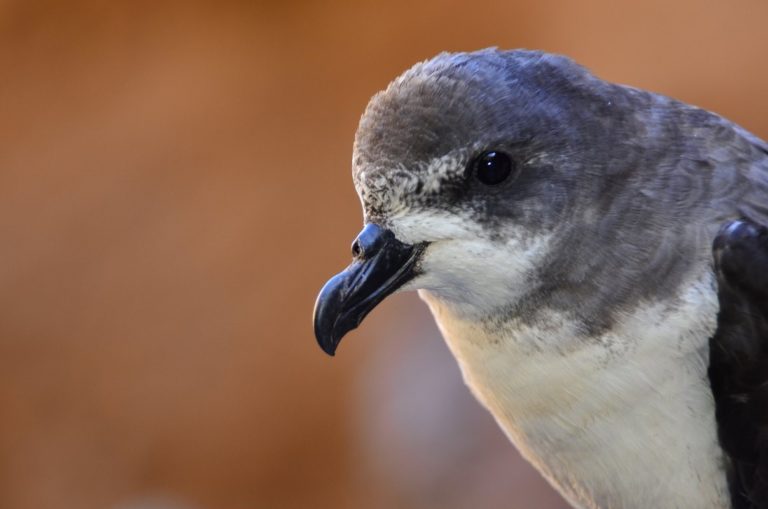
Cape Verde Petrel, close-up. (Fogo, Cape Verde.) © Sergi Torné

Cape Verde Petrel, close-up. (Fogo, Cape Verde.) © Jacob González-Solís

Cape Verde Petrel, close-up. (Fogo, Cape Verde; February 2010.) © Jacob González-Solís

Cape Verde Petrel, at nest with egg. (Fogo, Cape Verde.) © Jacob González-Solís
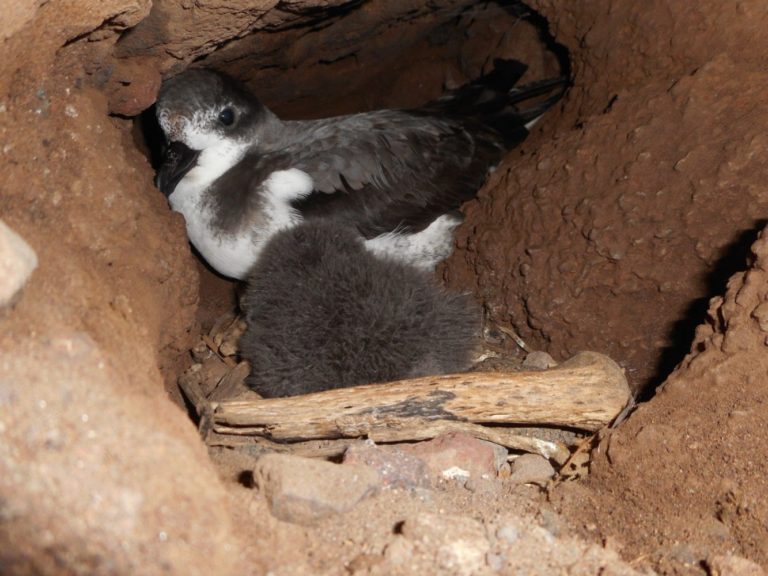
Cape Verde Petrel, adult in nest with nestling. (Fogo, Cape Verde.) © Jacob González-Solís
Cf. Desertas Petrel. Cape Verde and Desertas Petrels are effectively identical and have widely overlapping ranges: Desertas has a more extensive range that fully encompasses Cape Verde’s known range. Although their measurements and other features overlap, there are some differing tendencies. Desertas tends to have a heavier bill, especially its depth (vertical thickness) at the base, so Cape Verde’s bill is more evenly proportioned on average.
Cf. Zino’s Petrel. Desertas, Cape Verde, and Zino’s Petrels are very similar and have widely overlapping ranges: both Desertas and Zino’s have more extensive ranges that fully encompass Cape Verde’s known range. Most observations of individuals from this trio are at least somewhat ambiguous. Among the three, there is significant overlap in features and measurements. Nevertheless, Zino’s is often distinctive enough to identify with confidence.
Compared to Cape Verde and Desertas, Zino’s Petrel averages about 5-10% smaller in overall measurements (wingspan and total length), but 20-30% smaller in weight and bill length and depth, although it overlaps with Cape Verde at the margins. So Zino’s is slightly smaller in its outer dimensions, but proportionately slimmer and smaller-billed.
Zino’s also tends to have a paler head and more contrast on the underwings—often showing a whitish stripe down the middle of the wing (apparently never observed on Cape Verde or Desertas)—although plumage differences such as these are highly dependent on lighting and feather-wear.
Cf. Soft-plumaged Petrel. The Soft-plumaged Petrel of the southern oceans was traditionally considered conspecific with Zino’s, Desertas, and Cape Verde Petrels of the Atlantic Ocean. Desertas Petrel winters in the South Atlantic at latitudes where Soft-plumaged is very common, so they apparently overlap broadly, and Soft-plumaged was recently photographed in Norwegian waters, so it clearly has the potential to occur throughout the ranges of Zino’s, Desertas, and Cape Verde.
Soft-plumaged differs from the others in two principal features. First, soft-plumaged usually has a complete gray collar at the base of its throat, whereas the others have a gray cowl that rarely extends far down the sides of the neck. Second, on Soft-plumaged the rump and tail are approximately the same shade of gray as the upper back, whereas on the others the rump and tail are much paler.
In addition, Soft-plumaged usually has a mostly white forehead, whereas the others usually have gray foreheads—but forehead color seems to vary within each species to some extent. Finally, Soft-plumaged typically shows more extensive white or plae-gray on the underwings, usually extending to the bases of the primaries. In this respect, Zino’s can be similar, but usually has a whitish stripe limited to the coverts.
Notes
Monotypic species—or form, as it is often considered conspecific with Desertas Petrel (P. deserta), together comprising Fea’s Petrel (P. feae).
The internal taxonomy of this group remains unsettled. Fea’s Petrel was traditionally considered conspecific with Zino’s Petrel (P. madeira), collectively known as Fea’s Petrel (P. feae), which itself was previously regarded as a subspecies of Soft-plumaged Petrel (P. mollis). The subdivision of Soft-plumaged into at least three species is universally accepted. Since approximately 2010, the emerging consensus among Macaronesian seabird experts has been to take the further step of recognizing Cape Verde and Desertas Petrels as separate species, but this split remains controversial, at least in part because these two forms (unlike madeira and mollis) are not known to be distinguishable in the field. Consequently, Howell and Zufelt (2019) refer to these two forms as cryptic species that are separate in theory but in practice best considered a single species: Fea’s Petrel (P. feae).
IUCN Red List Status: Near Threatened.
References
Aves Marinhas de Cabo Verde. 2020. Gongon. https://avesmarinhasdecaboverde.info/aves-marinhas/gongon/. (Accessed October 6, 2020.)
BirdLife International. 2018. Pterodroma feae. The IUCN Red List of Threatened Species 2018: e.T22728011A132655668. https://dx.doi.org/10.2305/IUCN.UK.2018-2.RLTS.T22728011A132655668.en. (Accessed October 6, 2020.)
eBird. 2020. eBird: An online database of bird distribution and abundance. Cornell Lab of Ornithology, Ithaca, N.Y. http://www.ebird.org. (Accessed October 6, 2020.)
Garcia-del-Rey, E. 2011. Field Guide to the Birds of Macaronesia: Azores, Madeira, Canary Islands, Cape Verde. Lynx Editions, Barcelona.
Garcia-del-Rey, E. 2018. Birds of the Canary Islands. Christopher Helm, London.
Harrison, P. 1983. Seabirds: An Identification Guide. Houghton Mifflin, Boston.
Howell, S.N.G. 2012. Petrels, Albatrosses & Storm-Petrels of North America: A Photographic Guide. Princeton University Press, Princeton, N.J.
Howell, S.N.G., and K. Zufelt. 2019. Oceanic Birds of the World. Princeton University Press.
Ramos, R., I. Ramírez, V.H. Paiva, T. Militão, M, Biscoito, D. Menezes, R.A. Phillips, F. Zino, and J. González-Solís. 2016. Global spatial ecology of three closely-related gadfly petrels. Scientific Reports 6:23447. https://dx.doi.org/10.1038%2Fsrep23447.
Xeno-Canto. 2020. Fea’s Petrel – Pterodroma feae. https://www.xeno-canto.org/species/Pterodroma-feae. (Accessed October 6, 2020.)
